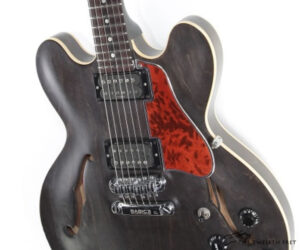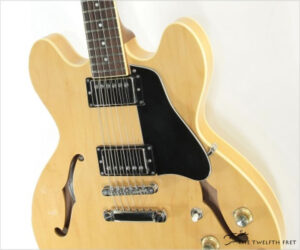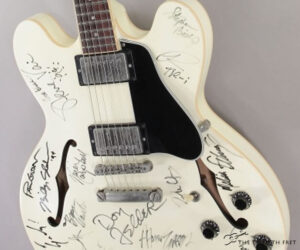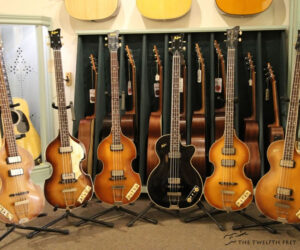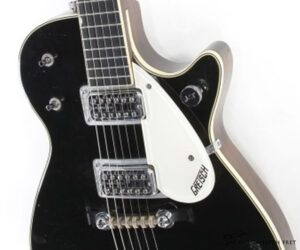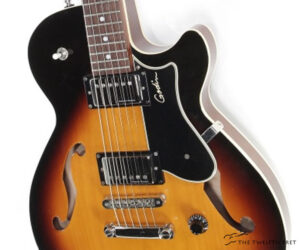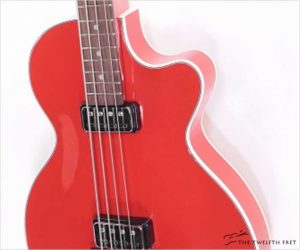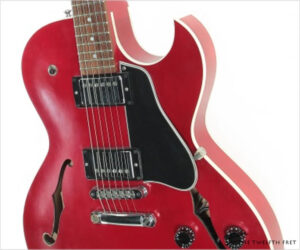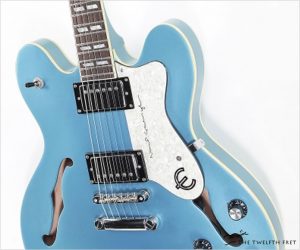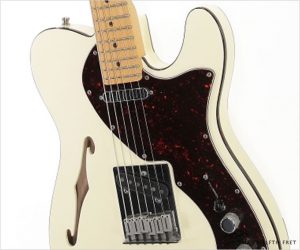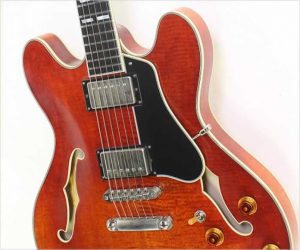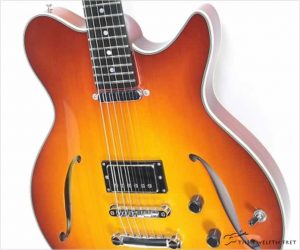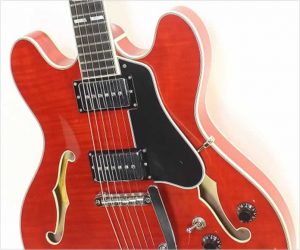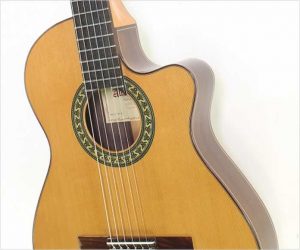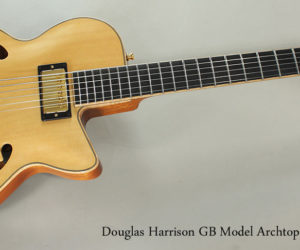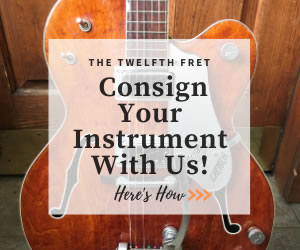For 2006, the Memphis plant introduced the Gibson Satin 335, a somewhat stripped down version of the classic design. Most noticeably, the fingerboard was unbound and the finish is satin – sunburst, cherry or translucent black as seen here. Later versions seem to have restored the fingerboard binding. These models were discontinued with the Memphis plant itself in 2019.
Thinline
Here is an excellent Epiphone Elitist ES-335 /NA in Natural finish, built during 2006 at the Terada plant in Nagoya, Japan. This is the same plant that builds many pro-line guitars, including Gretsch models, and this guitar illustrates the quality of their work. The Epiphone Elitist ES-335 is based on an early 1960’s Gibson ES-335 with dot position markers, but it is not an exact copy.
Conceived as ‘The Ultimate Signature Guitar,’ this autographed Gibson ES-335 Dot, conceived in 1991, boasts a striking Alpine White finish adorned with signatures from renowned guitarists. Originally donated by Gibson, this guitar became a centerpiece for a signature collection themed around the ‘Most Important Guitarists of the Last 10 Years,’ as chosen by readers of GUITAR Magazine in 1993.
A wide range of new Hofner Reissue Violin and Club Basses are in stock at The Twelfth Fret! Seen here are six brand new Hofner reissue 500/1 and 500/2 basses with reliced Varnish and Nitrocellulose Lacquer finishes.
Here’s a fantastic piece from early 1959, a Gretsch 6128 Duo Jet in Black Top finish. Just after this guitar was built, Gretsch altered the design to add a zero fret to the fingerboard. This is a great looking, playing and sounding guitar. It is one of the lightest electrics available at just over seven pounds (3.2kg), it plays well, and these Filter ‘Tron pickups are very good sounding. Introduced in 1954 just after the solid body, Pine capped 6130 Roundup, the chambered Duo Jet was aimed directly at Gibson’s Les Paul model, with a similar shape but very different yet hidden construction differences.
Introduced in 2013 at the winter NAMM show, the Godin Montreal Premiere HT has a thin trestle-braced arched top body and is ideal for jazz players. This Godin Montreal Premiere HT example is in very good, clean condition, dates to the first months of 2016 and was built at the Godin shops in La Patrie, Quebec with a mixture of domestic and imported woods. The top, back and sides are locally sourced Wild Cherry laminate with a Trestle or ML bracing system that supports and damps the body while reducing weight, and provides anchor points for the stop tailpiece.
Here’ s a new, old stock 2015 Hofner Gold Label Club Bass in solid red! The Club Bass is also known as the 500/2 – the 500/1 is the iconic violin shaped ‘Beatle Bass’. This is a ‘Gold Label’ model, one of a limited edition in custom colour. These models are built at the primary Hofner plant in Hagenau, Bavaria and are not always easy to find available for sale.
The Gibson ES-135H was the ‘Humbucker’ equipped version of the ES-135, a single-cut Semi-Hollow Archtop built in Memphis from 1991 to 2004. Many of these models used P-100 pickups – a stacked humbucker with the outline of a P-90. Some models used a Trapeze tailpiece, others as seen here a standard Tune-O-Matic and Stop Tailpiece combination.
Influenced heavily by the Sheraton used by Noel Gallagher in Oasis, the Epiphone Supernova was built from 1997 to 2005, with a signature pickguard and features making it the Noel Gallagher Supernova. It was available in a variety of finishes including the Manchester Blue seen here, and a custom Union Jack graphic.
The Fender Thinline Telecaster was introduced in 1969 as a design by Roger Rossmeisl, who had done major work for Rickenbacker. There have been a few versions of this model, and this particular 1998 example seems to me one of the best ever.
The Eastman T59 V is a take on one of the most successful and influential of Ted McCarty’s innovations, the thinline, semi-hollow archtop electric guitar. Around 1957, Gibson was looking to update its product line to address a number of issues, one of which was the rise in amplified stage volumes causing feedback. While the engineering team is credited with most of the design, it was apparently president Ted McCarty’s idea to put a solid Maple block through the center of the guitar.
The Eastman Romeo SC is a new limited edition thinline and largely hollow archtop electric design by Otto D’Ambrosio at the Eastman Custom Shop in California. Intended as an imagining of what ‘The Telecaster of the Archtop World’ would be, the Romeo started with defining its balance and player’s hand positions. The body is fairly small at 14.75 inches across, and the ‘Single Cut’ design gives plenty of access to the fretboard.
The Eastman T486B Thinline is an excellent take on the classic semi-hollow design introduced by Ted McCarty, president of Gibson, with the 1958 ES-335. Like most other versions of this design, the Eastman T486B uses pressed Maple Laminate for the top, back and sides, with a Maple block running down the center of the body. The top has a pair of F holes, and here they are bound. On the Eastman, the neck is Maple with a bound Ebony fingerboard sporting Split Block Parallelogram inlays (similar to an ES-345).
Part of the Conservatory line intended for serious students, the Alhambra 5PCT cutaway classical guitar verges into the area of ‘Crossover’ models, meant to make nylon string tone and responsiveness available to players in non-classical musical contexts. This model is based on the popular Alhambra 5P Conservatory Series Concert Classical guitar. Several factors help define the ‘Crossover’ models. Typically, the body has a cutaway and is thinner, and there’s a recognition that the guitar will be amplified. The thinner body reduced feedback, and the pickup and preamp help restore fullness.
This brand-new Douglas Harrison GB Custom thinline, chambered archtop guitar is just passing through, and we had to show it off.
